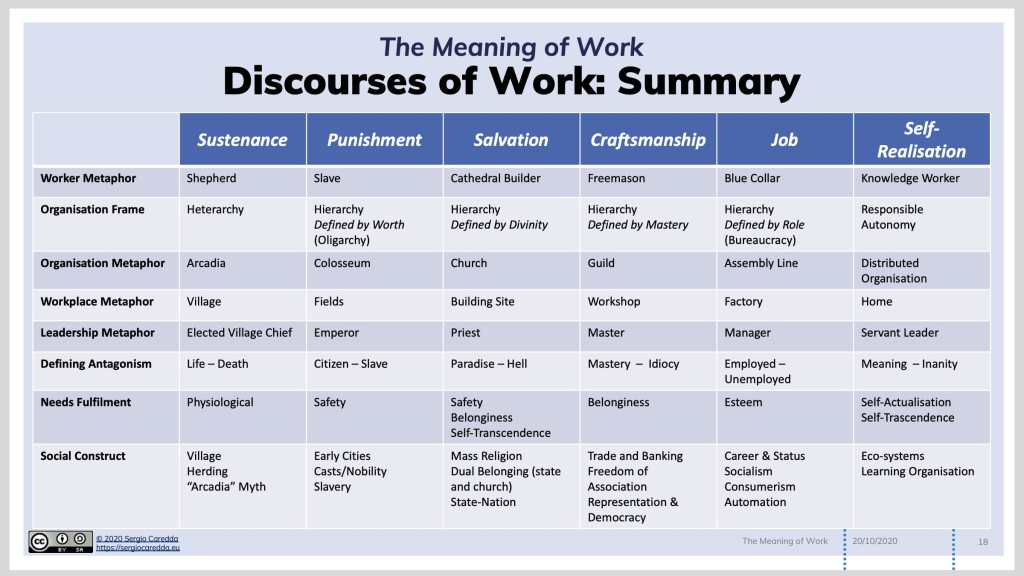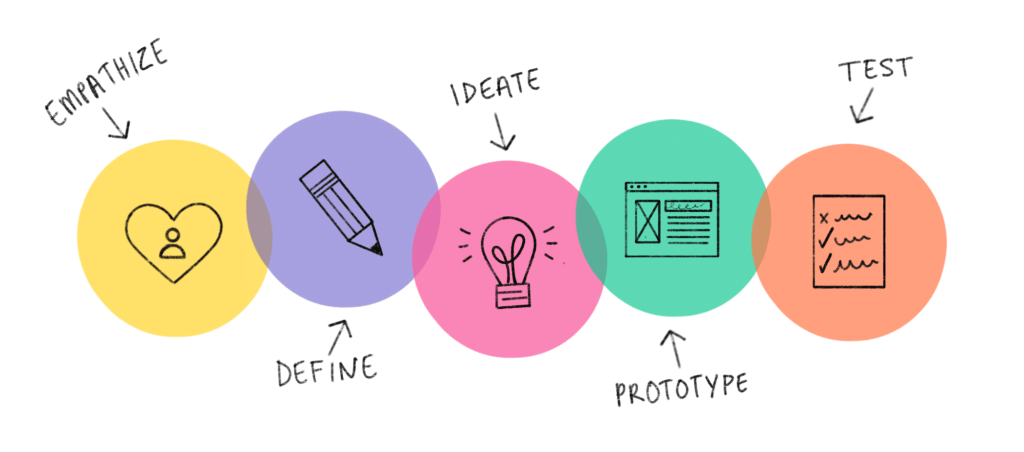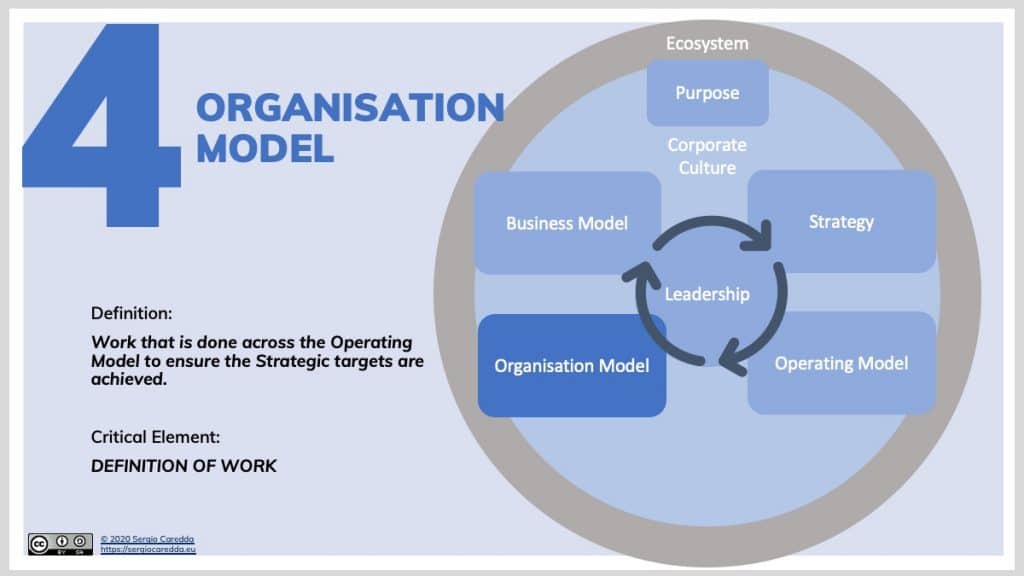Work Design. Our Ultimate Quest for the Meaning of Work has started with a Brief History of Work, where I tried to analyse the evolution of the meaning of work across time. I have then explored the framework of The Discourses of Work that I built, to underline how the meaning of Work evolved through history. I then I went deeper into the fifth discourse: Work as Job and in the last post, I analysed The New Discourse of Work that is currently emerging.
With this sixth article in the series, I want to bring back our reasoning on the organisational side, trying to understand what are the impacts of The New Discourse of Work at the connection point between people and organisations. I will do so by exploring the concept of Work Design, and how the interpretation of Work that each discourse developed, impact organisations differently.
Once again, this article is very much in progress, and am publishing it to collect as much feedback as possible. Feel free to comment directly at the end of this post any idea or remark you might have on its content.
The Discourses of Work: a Summary
Let me first sum up the key characteristics of the Discourses of Work as investigated in the last three articles. I have created a summary table that should be useful for this purpose.

For each of the discourses I have analysed which metaphor was used in terms of Worker, Organisation, Workplace and Leadership, what was the Organisation Frame, what the Defining Antagonism and what the Needs Fulfilment, plus I have indicated some of the Social Constructs that are dependent from that discourse of work.
One of the concepts that I want to underline again is that all these discourses resist today, in some shape and form. This is one of the elements that create complexity because we need to cater for each of the meanings that underline each of these discourses. The most critical example is that of Work as Punishment. We might believe this is not a truly current discourse. After all, slavery has been abolished. If we look at the stories of mass immigration, though, with the stories of exploitation, we can very well see how this discourse is alive and existing. Global Warming is condemning many rural communities, where the meaning of work would probably be more aligned to that of Sustenance, to move away and commit to different routes. That model, deeply rooted in an alignment with the rhythms of nature, is easily disrupted if the rhythms of nature change.
The challenge, once more, is understanding how each discourse mixes up into the next. One element that I have probably not underlined enough is that the transition between one discourse and the other was not easy.
Transitioning Discourses: the case of Guilds.
An example of the complexity of the transition from one discourse to the other can be seen in the history of guilds. I have indicated them as the Organisational Metaphor of the Work as Craftmanship discourse. But this didn’t happen overnight. The reality is that the first guilds were born to support the Salvation effort of its members. This was linked to the widening impact of the concept of Purgatory, which was diffusing itself in medieval Europe, and was recognised in 1275 by the Council of Lyon. The first objective of the initial guilds was the salvation of the soul of its members, by the collective prayer of its members. Guilds served as mechanisms for organizing, managing, and financing members’ collective quest for eternal salvation. We are fully within the Discourse as Salvation mechanism. What happened then?

Well, some of the most powerful guilds developed around professional activities that were not seen positively by the official doctrine of the Church. Commerce, banking, credit, are all activities that were tolerated, if not discouraged, despite their relevance. Often these professions were performed by non-Christians (the development of Jewish banking activities can be dated from this time). Moreover, guilds developed quickly political ambitions, dominating many cities. A big input in this direction came from the Black Death of the XIVth century. The impoverishment of several areas due to the plague created the need for more commerce. The Church and Governmental Institutions grew impoverished, and Guilds became, often, the only assistance that many people could seek for. In some areas, average individual income grew due to the enormous shrink in population, thus further reinforcing merchants guilds. In many cities, the focus of these guilds moved from the pious service of their origin to the management of the profession, establishing criteria for entry. In many areas of Italy guilds played an important role in trying to counterbalance the territorial expansion of the Catholic Church, now also evolving into its own state. Only after the Protestant Reform we will see guilds completely liberated by the religious origins (and not everywhere: there are many areas in Spain and Italy, for example, where the connection with religion is still visible today). In the centuries that followed, the evolution continued, and a strong link continued to be played on their political role. Let’s remember their role in the Third State in the French Revolution. Laicism became a distinctive trait only during Illuminism, and it is then that the libertarian elements of Guilds became more prominent.
The above is just an example that shows how discourses around work need decades, if not centuries, to form. Often, they coexist with the previous discourse for some time (if not a lot). The Discourse of Work as Craftsmanship is very well alive still today. How many professions do still exist, and are recognised because of the existence of professional standards? In Italy Guilds where in some cities called corporazioni, using the same root that makes the English word corporation. The idea of acting “as one body” is key to understanding their specificity over time. Yet, again, it also shows the complexity of evolution.
Work, Jobs and Organisation
When we speak about organisations in a business context, we mostly refer to for-profit firms. In a broad sense, an organisation is an organised group of people with a particular purpose. Family is probably the main form of human society that would not fall into this definition (as it misses the principle of being “organised”). Still, everything else would mostly fall into it. From the occasional club to a committee, to a governmental institution, a foundation, an association, a firm. Seen from this perspective, if we were able to count all organisations existing on Earth, the number of for-profit entities would be a definite minority. Yet, most of what we study in terms of organisation studies comes from the world of corporations (there’s also a body of study coming from the army, and public institutions).
As I have been writing on the topic of work, I came to realise that the meaning of work is much more related to the idea of organisation then we think. Before starting this journey, I fell in the view of considering work essentially as a synonym of employment, despite the long experience in non-profit, as this is still the very dominant narrative today. But if we abandon this idea, what types of work dio we have?
I believe we can find a new “topology” of organisations that can be based on work intensity, i.e. how much work is demanded from the individual. Think about your own experience. There are some organisations that require only very limited contribution in terms of “work” from you as an individual.
- Low Intensity. This would typically be an organisation that requires contribution in terms of work that is very much limited in time. Few examples come to mind. You could be selected as a jury member, in countries where this is standard. Another example is that of tellers, an important element in supporting elections. A more interesting example is the tax declarations we each have to do once a year. Effectively, we need to do some work to present them. All these are examples where the government is requesting some work to us as citizens.
There are examples of Low-Intensity work also in private instances. Depending on the case, the case of non-executive board directors could be an example (although the intensity of these roles can vary). Other examples can be: taking part in a research project, taking a test or certificate, taking part in a spontaneous committee and so on. - Medium Intensity. These are organisations that require more intensity (both in terms of frequency and commitment) to individuals. Continuing with the government example, military service is a type that is still common in some countries. It is often intense, but only for one year or so. Very few countries make it a larger commitment, and in some, it is only voluntarily. A strong example of Medium Intensity work comes from voluntary service, helping non-profits and NGOs (but also sometimes public institutions and so on) in their activities. The non-professional sport will also fall into this category if we start making the definition of work ampler.
- High Intensity. This is the area we more often refer to as work and would include the activities that take most of our time. Employment and Free-lance work would be the more traditional way of seeing it, as well as other professional work. Our standard expectation would be that these activities are used for the financial subsistence of the individual and the family. There are cases where, however, this linkage is not necessarily present. Housework is a typical example of a High-intensity work that is often not remunerated. Family care is another example. Moving to other sectors, a lot of artistic work is high-intensity, but its link with a remuneration might not be clear. Many artists need many years of practice, and sometimes a dose of good luck, before being able to “sell” their pieces.

The above starts to shape an important consideration: there are many different ways in which the relationship of an individual with an organisation that can happen through work. The reality is that most relationships between people and organisations happen in the form of work. Yet, I haven’t been able to find a lot of literature about how these relationships really operate, and how they are designed.
So, the big question, can we design Work?
Job Design
As we have seen, the concept of Jobs in organisations is akin to that of cogs into a watch. It portrays a mechanistic view of the organisation, whereby people are interchangeable pieces of the mechanism, by way of predetermined roles and responsibilities. Job Descriptions have become the core artefacts of legions of HR professionals, each adding its own twist. No wonder my rebellious spirit has always considered them dreadful. As I finished writing one, my question was always: how long will it last? Over time, we have added on top of the tasks and responsibility description several other features: competency models, skills description, compensation weighing mechanisms, career paths and so on.
I could try to find a better definition, but at the end of the day, the discipline of Job Design is about that: writing job descriptions. The concept itself of Job Design is “an odd idea” (Nicholson, 2010). It is a classic product of the mid-20th century concern about the demotivating effects of the technologies of factory and office production (Nicholson, 2010).
An aspect that has many different consequences, including the recent trend of Job Crafting. Definitely an exciting concept, from many different points of view. However, still embedded fully in the Work as Job discourse, whereby efficiency rests as the foundational criterion of evaluation. This is why we are called to check if an alternative exists.
The whole notion of the ‘‘job’’ invokes a world of discrete tasks embedded in organizational structures, and ‘‘job design’’ implies agents—employers—who determine the shape and location of these positions.
This is a very localized and top-down view of the world, which is hard to reconcile with much of (a) what preceded the industrial age, (b) what people do in the name of work outside the contexts of conventional employment, and (c) what has developed since in the new economy.Nigel Nicholson, The Design of Work – an Evolutionary Perspective, (2010)
We have been able to see what preceded the Industrial Age. And what has also been able to disconnect the concept of “work” from sole employment. In the last article, we have also been able to see the recent developments of the new economy. The ingredients are all there to see if a new, different way to imagine work is possible.
Moving towards Work Design
When we talk about Work Design, some would have their mind wondering immediately at workplace design. To be clear, this is not the idea that we want to pursue. Despite the most recent developments that promote a holistic view of the workplace, it still fully immerges the idea of Work into a location-based activity. And we have already challenged this assumption.
How can we then define Work Design? Nicholson gives an interesting perspective when he states the following. What is the ‘‘design of work’’ for an animal? It is the functionality of how its features and behaviors serve its biological needs. (Nicholson, 2010). For us Humans, then, Work Design becomes the way we connect our features and behaviours to serve our needs. He also makes a point that Work Design historically has been strictly connected to the design of individuality. And if we use the broader sense of work, this makes absolute sense.
What I want to do is to try to introduce some basic principles of Design Thinking to support the process.

I want to introduce a few reflection points to provide a framework for the first two steps in the process: Empathise and Define. The first element will focus on understanding the different types of workers, based on their needs, features and behaviours. The second will look instead at the identification of the problem that we want to truly address.
Empathise: Starting with Needs
We have already debated the connection of Work and Needs by citing Maslow’s Pyramid. I believe that we now go one step further, in trying to associate what the Meaning of Work can mean. I’m going to steal the concepts developed by Vishen Lakhiani as he created an interesting recoding of the Maslow’s Pyramid.
In his view, there has been an evolution on the needs. He suggests, therefore, to still consider the two foundation needs (physiological and safety), and substitute the other with Happiness, Abundance, Growth and Meaning (loosely coupled with belongings, esteem, self-actualisation and self-transcendence).
So are these really valid needs? I think they are great working elements, and a bit more comprehensible then Maslow’s somehow arcane wording. Applying standard Design Thinking principles, we would try to Design Work differently, depending on the specific needs of the individual, correct?
Physiological Needs.

When this need is more pressing, we simply want to ensure we have something to eat and water to drink. The design here would be in its simpler form, and it is what created the first communities of gatherers and hunters as we have seen. If an individual wants this level of needs to be fulfilled, proposing them a Job might be counterproductive. There are ample studies on the westernisation of primitive societies, and they all point out at how disruptive concepts such as work, private property and salary have been to these. For those individuals that, in the contemporary world, lounge to have a work that just looks at their physical needs, the design work is of simple acceptance and enablement. Again, there are examples of individuals and groups of people, that are trying to move back into a world of work simply aligned with the rhythm of nature, trying to develop self-sustaining communities where only goods-trade is allowed.
As an individual, what are the features and behaviours we would use more to connect ourselves with this need successfully?
- Physical Features such as strength and resistance are required, to cope with the work in the fields and the occasional hunting.
- Behaviours linked to community values, such as collaboration and support will develop. all supported, generally, by a high level of Agreeableness. Not only on work but on a number of activities, pursuing leisure time together in a collective effort of alignment with nature.
Safety Needs

This is the area where security becomes more important. The definition of what security means is probably different for each individual. We have seen a clear manifestation of this problem with many Gig Workers employed in food delivery, particularly in Europe. This is a clear example of Bad Work Design because there has not been careful attention in matching the needs of the worker and those of the organisation. Put it simply, and the idea was to use students that wanted to add some bucks to their monthly allowances for the service. This was the idea of the Gig, which was meant to work at another level of needs. The problem is that in some areas, this has become one of the few opportunities for long-term, unemployed people. Their need was that of safety. Thus the big issues in many countries.
As an individual, what are the features and behaviours we would use more to connect ourselves with this need successfully?
- Physical Features such as strength and resistance will be even more relevant, this time to prevail on others, seen as competitors. Not only: this is the area where Intelligence is also needed to focus and prevail, together with features such as agility, adaptability, ability to execute.
- Behaviours linked to successful execution will form, joint with Conscientiousness. Listening, particularly, will develop with all behaviours. Reliability will also be seen as a key behavioural feature. This is also an area where “satisfying the boss” can bring some deviant behaviours to surface, and we need to design keeping this in mind.
Happiness Needs.

This is the area where people focus more on relationships and love. A 1973 study showed that many employees stayed in one company for what was defined inertia (Flowers and Hughes, 1973). Yet that study showed for the very first time that a key component for people’s motivation at work was their network of relationships created at work. People not motivated by growth and career, but rather but the friendships created on the workplace. Yet, the reductionist approach often ended up expelling these employees because artificial passion was missing.
Here is where another easy faulty design process sometimes happens. We feel that creating. purpose as a company, declaring a number of values, working on a happiness strategy would be sufficient. It’s not, it’s not even useful. Because we need to embed in the Design of Work the understanding of what makes that person happy. In my experience, many jobs that we don’t even consider worth a design effort, because are replicated many times around the world, do offer plenty of opportunities for this Work Design activities. I’m thinking of sales associates and all frontline staff that has contact with the public. My experience tells me that for many of these people, often considered as “not worth” in terms of careers, the ability to be in close contact with customers aligns well with their need for happiness. Yet we’ve spent the last twenty years in trying to make this contact more complicated, through efficiency measures.
As an individual, what are the features and behaviours we would use more to connect ourselves with this need successfully?
- Physical Features that support the development of interpersonal bonds and relationships will be a focus, as well as all the elements that ensure accurate work. This is the field where we want to be just as productive as required, or as performing as required. Emotional intelligence in its widest sense will become a major asset to work well here.
- Behaviours will be linked particularly to Extraversion, and the capability to connect with others. Balancing work with other interests will probably be important, yet Work will constitute an important moment for our happiness, especially in its communal forms.
Abundance.

The need here can be seen often in terms of monetary terms, but also of status, recognition, internal and external motivation. The Work as Job discourse is particularly able to respond to this need for the managerial and executive portions of the workforce. Banking, Consulting, the general Financial Sector are all areas where this need is not just answered, is fuelled. The problem is that we have often ended up in designing vicious circles, where Overwork has become the norm.
If this need seems to be the one better matched by traditional job design practices, we need to stop one moment and reflect how many people have been “ejected” from the system because they were not matching expectations. Job is always designed from the employer perspective, never from the employee.
As an individual, what are the features and behaviours we would use more to connect ourselves with this need successfully?
- Physical Features that support hard work and commitment will be key focus elements. Elements that refer to appearance will be important, as we aim to be recognised. But all the elements linked to stress resistance will equally be critical.
- Behaviours linked to Neuroticism are critical here, balancing emotions and keeping focused on the targets we want to achieve. All the abilities to hide stress, to be always on, strong analytical mindsets, are all elements that will help support this need.
Growth

So much of management literature talks about the need to develop and grow people. We rarely see this, however, from an individual perspective. Yet this need is paramount for many individuals. The most solid attempt I have seen to create meaningful design that goes into this direction is that of the Deliberately Developmental Organisation illustrated by Robert Kegan and Lisa Laskow Lahey in their book An Everyone Culture. And it’s not by chance that I ended up listening to it as a (new) organisation model, because it needs a pervasive design of processes and tools to make it apparent.
This also means it is possible to Design Work for growth. Reality is that many individuals do exactly that. Artists, Researchers, Scientists, Musicians, Professional Players, are all categories of workers where the need for growth is pursued, and often visible in their resumés. The question that comes naturally is: are all people that have this need given the opportunity to pursue their work ideals?
As an individual, what are the features and behaviours we would use more to connect ourselves with this need successfully?
- Physical Features that support continuous learning will be key, such as curiosity and learning agility.
- Behaviours linked to Openness and Change are key to support this area. Interactions are focused on one’s growth in multiple directions, not just in depth, but also breadth of competences.
Meaning

This is the need more associated with the New Discourse of Work. Defining Meaning means taking a much broader view of what work and life mean altogether. This is not the room for a shiny declaration of piurpose, and that’s it. Rather, is the need that is being expressed by multiple angles to come back and reconnect the broken fabric of our lives, segmented between work and private life. The idea of “woirk-life balance” has probably been the biggest lie in managerial literature, serving solely to highlight the impossibility to balance two elements seen as opposing forces. You can’t be dedicated to both seemed the underlying message for both.
Yet, Meaning means also embarking in the through understanding of the real needs of a Human Being that transcend the physical life. Not necessarily spiritual in a religious sense, but definitely of realisation that moves beyond this level. For ages philosophers have lived this area, trying to make sense of the wholeness of the world. In a moment where we are living onlife more and more, we need to reconsider this even more.
As an individual, what are the features and behaviours we would use more to connect ourselves with this need successfully?
- Intellectual Features such as abstract thinking and systems thinking are required, to cope with the need for understanding the outside world. This joined with the capacity of sense-making, that connects our self with the environment.
- Behaviours would be those linked to self-development, in a much more holistic way. I believe that at this stage Human Beings would naturally flow towards a new form of collaborative behaviours, based on truly shared meaning and the abandoning of competitive stances.
Needs are Individual
I hope you have now got a broader view of the fact that different individuals will be looking for different things. What we need to acknowledge, however, is the fact that different individuals will still continue to pursue different needs. This can be linked to multiple factors, and also change in the process of their lives. Thinking that everybody can automatically move into a stage focused on meaning, would probably have the same damaging effect as considering everybody in the abundance level.
In the article Reinventing Work I had started discussing the fact that, as we investigate the transition into the new Discourse of Work, we can identify different types of workers from a social and economical point of view. As a society, I believe it is important to start imagining what we can do to move the entire world of work towards a more meaningful discourse. But this requires time, a focus on Education and Culture that is not an overnight engagement. As designers we need to focus on the current situation, instead, and think at what the current needs and wants of individuals are.
Define: What is the problem that we are trying to solve?
We need a new work culture that relies on the primal drive for autonomy and mastery in our work, the sense of belonging that comes from sharing goals and meeting them, and the impulse to gain the respect of those we respect.
Stowe Boyd, We Need A New Work Culture
Stowe Boyd has given a great definition of the issue we need to frame. He introduces the concept of Work Culture that I have not yet used, but that perfectly expresses the what we need to design. When we think of culture in its broad sense, we immediately think of a web of different components. Norms, behaviours, collective pattern, shared meanings, are all components of a consistent culture. Wether you agree on this naming or not, doesn’t really matter in reality: we need to however look at all these artefacts.
The definition of our design problem is: create a system of relationships capable of satisfying all the individual and societal needs for the meaning of work.
I am calling it a system of relationships and not an organisation for one very specific reason: we will have the organisation only if we are successful at this design effort. When I have introduced the Organisation Evolution Framework I have clearly marked the fact that one of the main components in Organisation Design is identifying the correct Definition of Work. This is not a trivial element.

The entire reasoning on this series on the Meaning of Work is linked to this specific conundrum, which carries a number of questions.
- Should we design an organisation based on one sole definition of the meaning of work?
- Is it possible to design organisations that can fulfil multiple meanings of work at the same time?
- Should an organisation pursue the objective of providing chances for individuals to question what meaning should work have for them?
My initial answer to these questions is that no, we should design organisations that are able to operate with multiple definitions of the meaning of work. In the past, most organisations have been built under the dominant discourse of Work as Job, fulfilling mostly the need of Security and Abundance. Thinking that we can create organisations that can solely focus on the need of meaning would bring up the same mistake.
So yes, we can design organisations that can fulfil multiple meanings, and effectively successful organisations have already been able to do this. Pockets of “autonomy and mastery”, using Boyd’s words, exist in many firms today, and this is often the great part of their success.
What I believe is that we need to build an organisation that intentionally chooses to advance work towards more meaningful patterns. Which again is something we find in some highly successful organisations today.
We need to design work to respect all of the individuals’ needs and design organisations to allow them to progress through stages of increasing meaning.
With this, the entire discussion about choosing one form or organisation or another, become sterile. What we need to do is intentionally choose a meaning of work that we want our organisation to stand for, making room however for all other meanings as well.
Building on Complementarities
I must admit that up until today, I had not really an idea on how this could be best achieved. Thanks to a chat on another topic with Antoinette Weibel, I have however found a name for this Complementarities. The concept has been used often in the theory of the firm domain, focusing however on production of complementary products and services, and is used often as a justification for outsourcing.
The idea here is instead to use the concept of complementarity to highlight the focus on strengths of differing components in the organisation design. Instead of trying to harmonise all components to an artificial level of performance, we try to focus on the differences that joined together can provide value.
A model of organisation that is capable of offering chances to individuals trying to address different meanings of work would have multiple advantages. We are aware, for example, that building fully self-managing organisations incurs in limits of scale. The levels of trust and autonomy needed for a full self-organising team are subject to Dunbars’ Number laws. It’s not a coincidence that scaling of many of the recent self-management models has been an issue. By appropriately exploring the individual features of people that do not want to work in a self-management model, for example, we can create hybrid solutions that can allow scale.
Traditional organisations have already done this for a lot of time. A traditional bureaucratic hierarchy might have triggered the focus on abundance as a source of meaning for the people interested in climbing the ladder. Still, in many ways, it relied on big numbers of individuals seeking happiness, security and sustenance to execute the bulk of the work. The downside is that these elements have been sawn in into the fabric of too many hierarchical models, creating a model that ended been unethical, as it squeezed individuals search for meaning depending on their level in the organisation.
The idea is not to replicate an exploitative model, but build on the shared value each type of needs can potentially create, creating a flourishing organisation model. This will allow, for example, a much easier adaptation to local cultures, the possibility to engage with businesses at different maturity levels, and the re-thinking of strategies around automation or artificial intelligence.
Above all the concept of complementarity needs to entail a dynamic context whereby individual needs are always taken into account.
Conclusion
This was a long post. And is probably the one that needs more refinement and reworks. It’s been in the work for over one month, yet I’m not 100% satisfied with it, and I need to continue to look through it more in detail. But again, my process is to put it out in the open to collect comments and feedbacks.
I hope that the main messages have passed through though. Next week I will publish the new version of the reinvent work article, which will become the conclusion on the societal needs that we need to frame.
Thanks for continuing to follow me into this journey.

Article by channel:
Everything you need to know about Digital Transformation
The best articles, news and events direct to your inbox
Read more articles tagged: Featured, Future of Work


